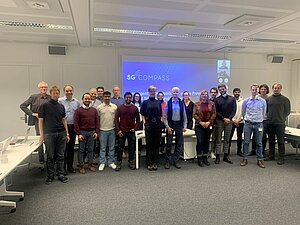December 12, 2023

Team members of the 5G-COMPASS project (Convergent Open Mobile and secure Provider-ASSisted 5G indoor and hotspot network) have come together for an important project meeting. At this meeting, the researchers presented the architecture of the building networks of the future. 5G-COMPASS aims to develop a heterogeneous indoor RAN (i-RAN) based on cost-effective, innovative and advanced LAN and Wi-Fi components. The i-RAN can be integrated into the 5G core network just like the conventional 5G RAN.
Over 80 percent of mobile data is currently generated and consumed in buildings, and the trend is rising. At the same time, the requirements for connection reliability are increasing for future applications in the Industrial Internet of Things (IIoT). Today's 5G solutions are mainly designed for outdoor use where they are unrivaled. Solutions for 5G networking in buildings, on the other hand, require additional infrastructure that is still very expensive.
5G-COMPASS addresses these challenges by further developing Fibre-to-the-Room (FttR) and Light Fidelity (LiFi), Powerline Communication (PLC) and Wi-Fi to meet future requirements for data rate, reliability, energy efficiency, latency and usability. The project aims to create a disaggregated architecture (Open RAN) that operates with open interfaces and advanced control. Open RAN makes efficient use of available network resources and ensures a higher quality of service. 5G-COMPASS strives for seamless roaming between technologies inside and outside buildings. This creates an innovative ecosystem for building networks.
"5G-COMPASS takes a disruptive approach to 5G building networking. Instead of installing 5G technology in millions of buildings, low-cost LAN and Wi-Fi networks are being developed to meet basic 5G requirements," says Prof. Volker Jungnickel, project coordinator at Fraunhofer HHI. "Buildings are usually interconnected via Ethernet, powerline and Wi-Fi. The entire building network can be connected to the core network like a 5G cell. This way, users no longer even notice that they are in the building network."
"Low latency and high reliability are key objectives of 5G-COMPASS. One fascinating solution is the coordination of neighboring access points. When potential interference can be detected before transmission, you can efficiently avoid it," comments Dr. Christoph Kottke, technical project manager at Fraunhofer HHI. "In addition to cables and radio, we are seeing increasing use of optical technologies in buildings. Fiber-to-the-room (FttR) and light fidelity (LiFi) enable higher data rates as well as greater security and centimetre-precise positioning."
5G-COMPASS is funded as part of the "Innovative Network Technologies" research and innovation program of the Federal Ministry for Digital and Transport Affairs (BMDV) over a period of two years with the amount of 11 million Euros. The program aims to promote the development of open network architectures and thereby contribute to Germany's digital transformation and sovereignty. The partners from industry include MaxLinear, T-Systems, Devolo, Teleconnect, Quanticor, NewMedia-NET, Karl Leibinger Medizintechnik, Teraki and SurgiTAIX. In addition to the Fraunhofer Heinrich Hertz Institute (HHI), the following research partners are involved: ICCAS - University Medicine Leipzig, Werner-von-Siemens Center for Industry and Science, Technical University of Braunschweig, Nordhausen University of Applied Sciences and the Technical University of Munich.